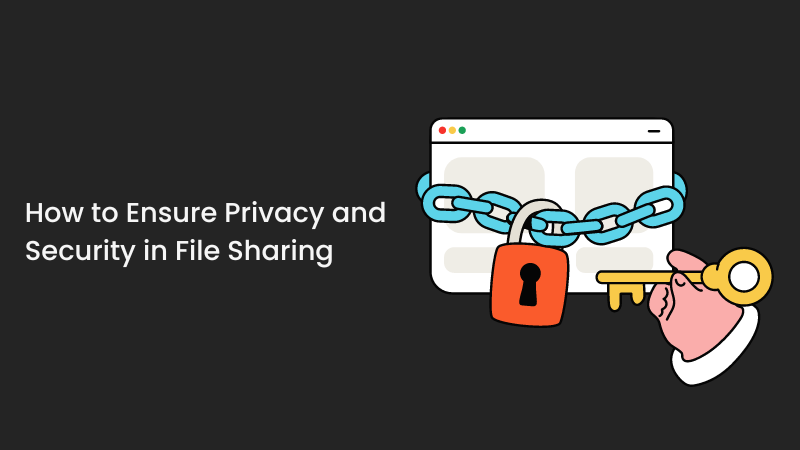When sharing sensitive information with colleagues, clients, or consultants – it’s important that it remains private and secure. Could you imagine if government official documents got leaked? The world may turn into chaos. To prevent such an event, it’s important to ensure the privacy and security of documents while file sharing. Luckily, we’ve evolved past the archaic methods of faxing and printing documents to hand out in person. The convenience of file sharing now lies in secure online methods for easy and secure file transfer.
In this article, we will be discussing the most important methods to adopt for online file sharing in order to protect the integrity of the information you share online.
How to Ensure Privacy and Security in File Sharing
1. Use Secure File Sharing Services
One of the most important things you can do to ensure privacy and security in file sharing is to use a secure file sharing service. There are several services available that offer state-of-the-art security features to protect your documents as they traverse the internet. Software, such as TitanFile, automatically encrypts documents the moment they’re uploaded to the platform. This ensures only the intended recipient can access and read the information shared. Additionally, all documents are protected in transit, at rest, and end-to-end so unauthorized users cannot hack you.
Rather than becoming gradually frustrated learning to manually encrypt files, which can be time-consuming and stressful – Automatic encryption takes that frustration away while providing more secure results.
2. Password-Protect Your Files
Why not double up on your security practices and use password protection in addition to file sharing software? Password protection is an easy and effective way to ensure the security of your shared files. In the event that an unauthorized user intercepts your files online, your information is as good as gone if it wasn’t encrypted. However, if you password-protect your documents with a strong password, the unauthorized user would need that password to actually access the document’s content. It’s important to not only password protect your documents but create a strong password that is difficult to guess by others.
Pro tip: When sharing a file, make sure to share the password separately with the recipient, not in the same email or message as the file link. This will ensure if the email or message is hacked, they will not have the password as well.
3. Use Two-Factor Authentication
Two-factor authentication is a necessity for people who deal with confidential information. A password acts as the first line of defence for accounts, but 2FA is that additional blockade. In addition to your password, 2FA requires you to enter a unique code in order to access your account. Users can set up SMS messages to receive the code or use an authenticator app, like Google Authenticator, to receive the code. This makes it much more difficult for hackers to gain access to your files.
2FA comes in especially handy if a hacker has cracked your account password. Without two-factor authentication, they would now have access to all of your account information which can be used to steal your identity, blackmail you, or worse. With 2FA, unless the hacker also has your mobile device, they will be unable to access your account.
4. Set Expiration Dates on Shared Links
When you share a file, it is important to set an expiration date on the link. This ensures that the file is only accessible for a limited time and can’t be accessed by unauthorized users after the time limit has expired. This is especially important for sensitive files that contain personal or confidential information.
5. Avoid Using Public Wi-Fi
As delicious as that six-piece nugget combo is, what isn’t delicious is identity theft – which can easily happen if you use public wi-fi to access your accounts online. Public Wi-Fi networks are not secure because they are open and unencrypted, meaning anyone can connect to them without authentication or a password. This makes it easy for hackers and cybercriminals to intercept network traffic and capture sensitive information, such as usernames, passwords, credit card numbers, and other personal data.
Users are also vulnerable to man-in-the-middle attacks, where a hacker intercepts communication between two devices to steal data or inject malicious code because these networks are shared by a plethora of people.
Pro tip: If you connect to public wi-fi, make sure you’re connected to a VPN to secure the network and your information.
6. Keep Your Software Up To Date
Keeping your software up to date is an essential part of ensuring the security of your files. Software updates often include security patches that address vulnerabilities and protect against potential attacks. Unfortunately, we have seen events where multi-national corporations’ lack of software updates resulted in the theft of millions of users’ information. It’s a simple protective measure and should be done regularly.
Make sure to update your operating system, web browser, and any other software used for file sharing regularly.
7. Enable Advanced Sharing Permissions
To ensure privacy and security when transferring files, it’s important to enable advanced sharing permission. When using software, like TitanFile, users have the ability to enable advanced sharing permissions which gives a heightened level of granular control. Admins can decide which groups can access and modify shared resources, files, or folders which allows you to grant or restrict access to specific users or groups, providing better security and control over your shared resources.
Always check your file permissions to ensure that only the intended recipient can access it.
Conclusion
File sharing has become an integral part of our daily lives and is required for the smooth operation of our businesses. However, it’s important to highlight the threats that exist online and the consequences of not protecting your documents. By following these best practices, you can protect your files from potential attacks and ensure that only the intended recipient has access to your files. Always stay vigilant!

